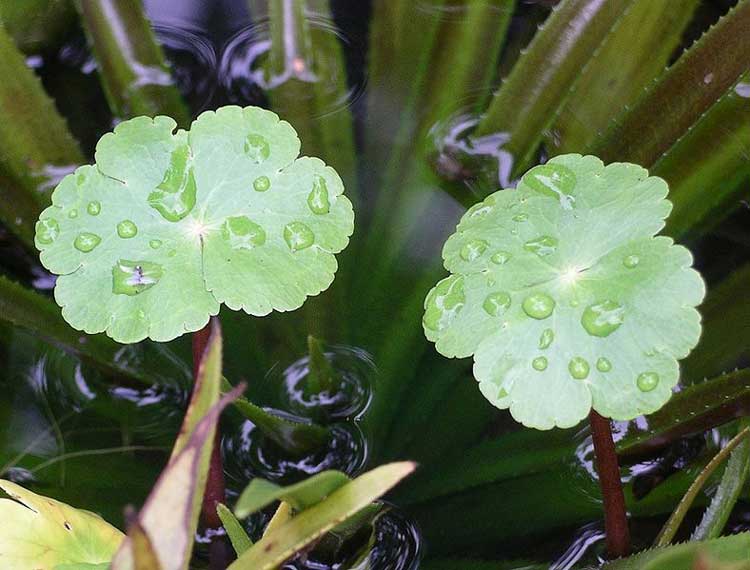
Hydrocotyle ranunculoides (*)
Classification System: APG IV
Superregnum: Eukaryota
Regnum: Plantae
Cladus: Angiosperms
Cladus: Eudicots
Cladus: Core eudicots
Cladus: Asterids
Cladus: Campanulids
Ordo: Apiales
Familia: Araliaceae
Subfamilia: Hydrocotyloideae
Genus: Hydrocotyle
Species: Hydrocotyle ranunculoides
Name
Hydrocotyle ranunculoides L.f.
Synonyms
Hedera natans Cyr.
Hydrocotyle adoensis Hochst.
Hydrocotyle americana Walt.
Hydrocotyle batrachioides DC.
Hydrocotyle cymbalarifolia Muhl.
Hydrocotyle natans Torrey
Hydrocotyle prolifera Otto ex Sweet
Hydrocotyle ranunculoides f. minima O. Ktze.
Homonymns
Hydrocotyle ranunculoides Bl. = Hydrocotyle sibthorpioides Lam.
Hydrocotyle ranunculoides Heyne ex Wall. = Hydrocotyle javanica Thunb.
Distribution
Native distribution areas:
Continental: Northern America
USA (Alabama, Arkansas, Arizona, California, District of Columbia, Delaware, Florida, Georgia, Illinois, Kansas, Kentucky, Louisiana, Maryland, Mississippi, North Carolina, New Jersey, New York, Ohio, Oklahoma, Oregon, Pennsylvania, South Carolina, Tennessee, Texas, Virginia, Washington State, West Virginia), Mexico (Aguascalientes, Baja California Norte, Baja California Sur, Chihuahua, Coahuila, Ciudad de Mexico, Durango, Guanajuato, Guerrero, Hidalgo, Jalisco, Mexico State, Michoacan, Morelos, Nuevo Leon, Oaxaca, Puebla, Queretaro, San Luis Potosi, Sonora, Tlaxcala, Veracruz, Zacatecas)
Continental: Southern America
Costa Rica, Panama, Cuba, Peru, Nicaragua, Guatemala, Bolivia (Beni, Chuquisaca, Cochabamba, La Paz, Pando, Santa Cruz, Tarija), NE-Brazil (Bahia), SE-Brazil (Minas Gerais, Espirito Santo, Sao Paulo, Rio de Janeiro), Argentina (Buenos Aires, Chaco, Chubut, Cordoba, Corrientes, Entre Rios, Formosa, Jujuy, La Pampa, La Rioja, Mendoza, Neuquen, Rio Negro, Salta, Santa Cruz, Santiago del Estero, Santa Fe, San Juan, San Luis, Tucuman), S-Brazil (Parana, Rio Grande do Sul, Santa Catarina), Chile (Coquimbo, Valparaiso, O'Higgins, Maule, Bio Bio, Araucania, Los Lagos, Reg. Metropolitana), Paraguay (Caazapa, Pres. Hayes), Uruguay (Colonia, Montevideo, Soriano), Venezuela (Aragua, Miranda, Tachira), Ecuador, Colombia (Antioquia, Boyac, Cauca, Cundinamarca, Quindo, Risaralda)
References: Brummitt, R.K. 2001. TDWG – World Geographical Scheme for Recording Plant Distributions, 2nd Edition
References
Linnaeus, C. (filius) , 1782. Supplementum Plantarum Systematis Vegetabilium Editionis Decimae Tertiae, Generum Plantarum Editiones Sextae, et Specierum Plantarum Editionis Secundae. Editum a Carolo a Linné. Brunsvigae [Braunschweig] 177. 1782 ("1781")
Links
Hassler, M. 2018. Hydrocotyle ranunculoides. World Plants: Synonymic Checklists of the Vascular Plants of the World In: Roskovh, Y., Abucay, L., Orrell, T., Nicolson, D., Bailly, N., Kirk, P., Bourgoin, T., DeWalt, R.E., Decock, W., De Wever, A., Nieukerken, E. van, Zarucchi, J. & Penev, L., eds. 2018. Species 2000 & ITIS Catalogue of Life. Published online. Accessed: 2018 Nov. 18. Reference page.
International Plant Names Index. 2018. Hydrocotyle ranunculoides. Published online. Accessed: Nov. 18 2018.
The Plant List 2013. Hydrocotyle ranunculoides in The Plant List Version 1.1. Published online. Accessed: 2018 Nov. 18.
Tropicos.org 2018. Hydrocotyle ranunculoides. Missouri Botanical Garden. Published online. Accessed: 18 Nov. 2018.
USDA, ARS, Germplasm Resources Information Network. Hydrocotyle ranunculoides in the Germplasm Resources Information Network (GRIN), U.S. Department of Agriculture Agricultural Research Service. Accessed: 09-Oct-10.
Vernacular names
English: Floating marshpennywort
español: Sombretillo de Agua
magyar: Hévízi gázló
Hydrocotyle ranunculoides, known commonly as floating pennywort, or floating marshpennywort, is an aquatic plant in the family Apiaceae. It is native to North and South America.
Origin and invasiveness
Water pennywort is an aquatic plant, native to the Americas. Due to its popularity as a pond plant, and subsequent escape into rivers, it has established as an invasive alien species in parts of Europe, Australia, Africa and Japan.[1][2][3] It was one of five aquatic plants which were banned from sale in the UK from April 2014, and was the first prohibition of its kind there.[4] On the other hand, it is in decline in parts of its range in the United States.[5]
In Europe, floating pennywort is included since 2016 in the list of Invasive Alien Species of Union concern (the Union list).[6] This implies that this species cannot be imported, cultivated, transported, commercialized, planted, or intentionally released into the environment in the whole of the European Union.[7]
Description
Water pennywort has stems that spread horizontally and can float on water.[8] Leaves grow on petioles up to 35 cm long, and are round to kidney-shaped, with 3–7 lobes and crenate to entire margins.[9] Flowers are small, pale greenish white to pale yellow, and come in umbels of 5–13.[8] Fruits are small achenes that can float, helping the seeds to disperse.[8]
The South American weevil Listronotus elongatus lays eggs on and eats the floating pennywort, and larvae also eat into the stems, reducing the pennywort's ability to grow. The weevil has been introduced for biocontrol of the floating pennywort into waterways in Britain, following extensive research to establish that the weevil is not a threat in itself.[10]
References
"Hydrocotyle ranunculoides (floating pennywort)". Invasive Species Compendium. Retrieved 3 February 2021.
"Invasive non-native species - indicator two". Environment Agency. Archived from the original on 13 May 2010. Retrieved 28 August 2017.
"Aquatic invaders threat to biodiversity". The Ecologist. Retrieved 2017-08-28.
Kinver, Mark (2013-01-29). "UK bans sale of five invasive non-native aquatic plants". BBC News. Retrieved 2017-08-28.
"Plants Profile for Hydrocotyle ranunculoides (floating marshpennywort)". USDA, NRCS. 2021. The PLANTS Database. National Plant Data Team, Greensboro, NC 27401-4901 USA. Retrieved 2021-02-03.
"List of Invasive Alien Species of Union concern - Environment - European Commission". ec.europa.eu. Retrieved 2021-07-27.
"REGULATION (EU) No 1143/2014 of the European parliament and of the council of 22 October 2014 on the prevention and management of the introduction and spread of invasive alien species".
John, Hilty. "Water Pennywort". Illinois Wildflowers. Retrieved 16 December 2012.
"H. ranunculoides". Jepson Manual. University of California. Retrieved 16 December 2012.
Horton, Helena (17 May 2022). "South American weevils released in UK waterways to tackle invasive weed". The Guardian.
Retrieved from "http://en.wikipedia.org/"
All text is available under the terms of the GNU Free Documentation License

